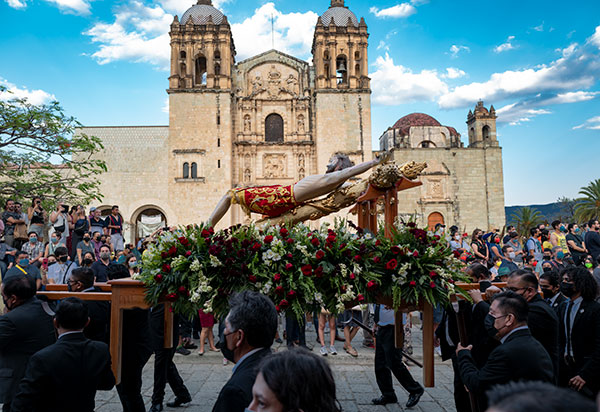My wife Amy and I try to make the journey from our village into Oaxaca whenever events of deep cultural meaning unfold. These are times when the city reveals its soul—rituals layered with history, symbolism, and reverence. I come with my camera, ready to bear witness.
On Good Friday, we stood quietly among the crowd gathered for the Procesión del Silencio. The streets were full, yet hushed. The procession began late—the priest was delayed—but no one complained. Participants stood motionless, their black and white garments a testament to mourning and devotion. The statue of the Virgin waited too, crowned and serene, above a bed of flowers.
Nothing began until the priest finished his sermon at the steps of the Templo de la Preciosa Sangre de Cristo, a baroque church in the heart of Oaxaca’s historic center. Only then did the ancient ritual unfold—a tradition that has taken root here since colonial times and is based on Holy Week observances from Seville, Spain.
Standard bearers stepped forward, holding aloft banners richly embellished with sacred icons. Various parishes had offered their most venerated images and relics for the occasion, each one reverently borne on the shoulders of men. The weight of the divine—honored with every careful step.
Then came a procession of men wearing only loincloths and hoods, penitentes, their faces hidden, their bodies straining under immense wooden crosses. The timbers scraped loudly against the pavement, a visceral soundtrack to the unspoken agony and devotion representatively etched into each step they took. The sound echoed through the silence—raw, ancient, unforgettable.
There was no music. Only the sound of footsteps, the rustling of lace veils, the scraping of wood, and the unspoken language of shared faith.
In moments like this, Amy and I feel a deep sense of gratitude. Though we are transplanted Americans, we are welcomed here—not as strangers, but as neighbors. And in the silence of this sacred procession, we felt it again: the quiet power of belonging.
⸻
For those unfamiliar with this powerful tradition, the Procesión del Silencio is a Catholic ritual that dramatizes the sorrow of the Virgin Mary, La Dolorosa; following the crucifixion of Christ. It originated in Spain and was brought to Latin America during the colonial period, becoming a central part of Holy Week in many cities, including Oaxaca. The silence is a symbol of mourning, penitence, and reverence.


















